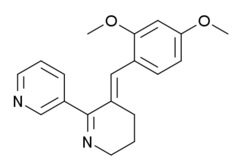GTS-21
 | |
| Clinical data | |
|---|---|
| Other names | 3-(2,4-dimethoxy-benzylidene)anabaseine |
| Identifiers | |
| |
| CAS Number | |
| PubChem CID | |
| ChemSpider | |
| UNII | |
| CompTox Dashboard (EPA) | |
| Chemical and physical data | |
| Formula | C19H20N2O2 |
| Molar mass | 308.374 g·mol−1 |
| 3D model (JSmol) | |
| |
| |
| (verify) | |
This article needs to be updated. (April 2015) |
GTS-21 (DMXBA) is a derivative of the natural product anabaseine that acts as a partial agonist at neural nicotinic acetylcholine receptors. It binds to both the α4β2 and α7 subtypes, but activates only the α7 to any significant extent.[1][2]
Both GTS-21 itself and its demethylated active metabolite 4-OH-GTS-21[3] display nootropic[4] and neuroprotective effects,[5][6][7][8] and GTS-21 is being investigated for the treatment of Alzheimer's disease,[9] nicotine dependence,[10] and, most significantly, for schizophrenia.[11][12][13][14][15]
The laboratory name GTS-21 means that it is the 21st chemical compound created by Gainesville (University of Florida in Gainesville) and Tokushima (Taiho Pharmaceutical) Scientists.[16] DMXB-A – 3-2,4-dimethoxybenzylidene anabaseine.
References
- ^ Briggs CA, Anderson DJ, Brioni JD, Buccafusco JJ, Buckley MJ, Campbell JE, Decker MW, Donnelly-Roberts D, Elliott RL, Gopalakrishnan M, Holladay MW, Hui YH, Jackson WJ, Kim DJ, Marsh KC, O'Neill A, Prendergast MA, Ryther KB, Sullivan JP, Arneric SP (1997). "Functional characterization of the novel neuronal nicotinic acetylcholine receptor ligand GTS-21 in vitro and in vivo". Pharmacology, Biochemistry, and Behavior. 57 (1–2): 231–41. doi:10.1016/S0091-3057(96)00354-1. PMID 9164577. S2CID 205923953.
- ^ Meyer EM, Tay ET, Papke RL, Meyers C, Huang GL, de Fiebre CM (September 1997). "3-[2,4-Dimethoxybenzylidene]anabaseine (DMXB) selectively activates rat alpha7 receptors and improves memory-related behaviors in a mecamylamine-sensitive manner". Brain Research. 768 (1–2): 49–56. doi:10.1016/S0006-8993(97)00536-2. PMID 9369300. S2CID 13104716.
- ^ Meyer EM, Kuryatov A, Gerzanich V, Lindstrom J, Papke RL (December 1998). "Analysis of 3-(4-hydroxy, 2-Methoxybenzylidene)anabaseine selectivity and activity at human and rat alpha-7 nicotinic receptors". The Journal of Pharmacology and Experimental Therapeutics. 287 (3): 918–25. PMID 9864273.
- ^ Kitagawa H, Takenouchi T, Azuma R, Wesnes KA, Kramer WG, Clody DE, Burnett AL (March 2003). "Safety, pharmacokinetics, and effects on cognitive function of multiple doses of GTS-21 in healthy, male volunteers". Neuropsychopharmacology. 28 (3): 542–51. doi:10.1038/sj.npp.1300028. PMID 12629535.
- ^ Meyer EM, King MA, Meyers C (March 1998). "Neuroprotective effects of 2,4-dimethoxybenzylidene anabaseine (DMXB) and tetrahydroaminoacridine (THA) in neocortices of nucleus basalis lesioned rats". Brain Research. 786 (1–2): 252–4. doi:10.1016/s0006-8993(97)00300-4. PMID 9555043. S2CID 325503.
- ^ Shimohama S, Greenwald DL, Shafron DH, Akaika A, Maeda T, Kaneko S, Kimura J, Simpkins CE, Day AL, Meyer EM (January 1998). "Nicotinic alpha 7 receptors protect against glutamate neurotoxicity and neuronal ischemic damage". Brain Research. 779 (1–2): 359–63. doi:10.1016/s0006-8993(97)00194-7. PMID 9473725. S2CID 54342132.
- ^ Li Y, Meyer EM, Walker DW, Millard WJ, He YJ, King MA (May 2002). "Alpha7 nicotinic receptor activation inhibits ethanol-induced mitochondrial dysfunction, cytochrome c release and neurotoxicity in primary rat hippocampal neuronal cultures". Journal of Neurochemistry. 81 (4): 853–8. doi:10.1046/j.1471-4159.2002.00891.x. PMID 12065644. S2CID 41950110.
- ^ de Fiebre NC, de Fiebre CM (November 2003). "Alpha 7 nicotinic acetylcholine receptor-mediated protection against ethanol-induced neurotoxicity". Alcohol (Fayetteville, N.Y.). 31 (3): 149–53. doi:10.1016/j.alcohol.2003.08.006. PMID 14693263.
- ^ Kem WR (August 2000). "The brain alpha7 nicotinic receptor may be an important therapeutic target for the treatment of Alzheimer's disease: studies with DMXBA (GTS-21)". Behavioural Brain Research. 113 (1–2): 169–81. doi:10.1016/s0166-4328(00)00211-4. PMID 10942043. S2CID 39523754.
- ^ Foulds J, Burke M, Steinberg M, Williams JM, Ziedonis DM (May 2004). "Advances in pharmacotherapy for tobacco dependence". Expert Opinion on Emerging Drugs. 9 (1): 39–53. doi:10.1517/14728214.9.1.39. PMID 15155135. S2CID 219187104.
- ^ Simosky JK, Stevens KE, Freedman R (April 2002). "Nicotinic agonists and psychosis". Current Drug Targets. CNS and Neurological Disorders. 1 (2): 149–62. doi:10.2174/1568007024606168. PMID 12769624.
- ^ Martin LF, Kem WR, Freedman R (June 2004). "Alpha-7 nicotinic receptor agonists: potential new candidates for the treatment of schizophrenia". Psychopharmacology. 174 (1): 54–64. doi:10.1007/s00213-003-1750-1. PMID 15205879. S2CID 21557412.
- ^ Olincy A, Harris JG, Johnson LL, Pender V, Kongs S, Allensworth D, Ellis J, Zerbe GO, Leonard S, Stevens KE, Stevens JO, Martin L, Adler LE, Soti F, Kem WR, Freedman R (June 2006). "Proof-of-concept trial of an alpha7 nicotinic agonist in schizophrenia". Archives of General Psychiatry. 63 (6): 630–8. doi:10.1001/archpsyc.63.6.630. PMID 16754836.
- ^ Olincy A, Stevens KE (October 2007). "Treating schizophrenia symptoms with an alpha7 nicotinic agonist, from mice to men". Biochemical Pharmacology. 74 (8): 1192–201. doi:10.1016/j.bcp.2007.07.015. PMC 2134979. PMID 17714692.
- ^ Freedman R, Olincy A, Buchanan RW, Harris JG, Gold JM, Johnson L, Allensworth D, Guzman-Bonilla A, Clement B, Ball MP, Kutnick J, Pender V, Martin LF, Stevens KE, Wagner BD, Zerbe GO, Soti F, Kem WR (August 2008). "Initial phase 2 trial of a nicotinic agonist in schizophrenia". The American Journal of Psychiatry. 165 (8): 1040–7. doi:10.1176/appi.ajp.2008.07071135. PMC 3746983. PMID 18381905.
- ^ Yokoyama T, Ishikawa T, Ban K, Saitoh H (1987). "[Thirteen-year-old girl presenting chorea after treatment of hyperthyroidism]". No to Hattatsu. 19 (5): 408–14. PMID 3663414.
